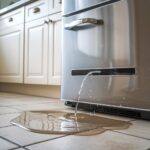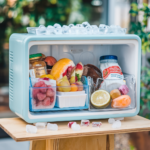You’re not alone if your ice maker is acting up, whether it’s a Whirlpool, Samsung, or a commercial unit. Ice makers can encounter various issues, but many problems are manageable with some troubleshooting. This guide outlines the steps to identify and resolve common ice maker issues.
Our Services:
Microwave Repair Service in Southern CaliforniaWasher Repair Service in Southern California
Freezer Repair Service in Southern California
Dishwasher Repair Service in Southern California
Refrigerator Repair Service in Southern California
1. Troubleshooting Common Ice Maker Problems
When faced with an ice maker that has suddenly stopped functioning, it’s essential to begin with some basic checks. Start by ensuring that the ice maker is powered on and connected. Additionally, verify that the settings are correctly adjusted. Next, inspect the water supply. Ensure the water line is securely connected and has sufficient water pressure, and clean the filters. If the ice maker remains unresponsive, check the freezer temperature. Most ice makers require a temperature around 0°F (-18°C) to function optimally. Adjust the temperature settings as necessary. If you encounter specific issues, such as a refrigerator that makes ice but does not dispense water, it is likely due to a separate problem with the water dispenser line. Conversely, double-check the temperature and water flow if no ice forms in the freezer.
2. Brand-Specific Solutions for Whirlpool and Samsung Ice Makers
For Whirlpool models, a quick reset might resolve issues. Check for a reset button on the ice maker or refer to the user manual for guidance. If you are dealing with a Samsung ice maker that isn’t working, consider resetting the unit by holding the reset button for 8 to 10 seconds or until you hear a beep. If the ice maker remains unresponsive, check for blockages caused by ice buildup and inspect the water inlet valve, which can often lead to issues.
3. Addressing Ice Production Problems
There are several reasons your ice maker may not be producing enough ice. One common cause is a clogged water filter, which can restrict water flow. Replacing the filter every six months is recommended to maintain optimal performance. Additionally, ensure that your water pressure is above 20 psi, as low pressure can significantly impact ice production. If your refrigerator is making ice but not dispensing water, this often indicates a problem with the ice maker motor, which may have failed. In contrast, the water dispenser continues to operate. In such cases, check the motor and replace it if necessary.
4. Dealing with Freezing and Temperature Issues
If your ice maker is freezing up, it could be due to excess moisture or incorrect freezer temperatures. To address this, check the temperature settings and ensure your freezer is not excessively cold. The freezer is ideal for remaining between -18°C and -15°C. To clear the ice buildup, turn off the ice maker, unplug the appliance, and allow the ice to melt. You can expedite this process using a hair dryer on a low setting. If your ice maker is not freezing water, inspect the thermostat, as a malfunctioning thermostat can disrupt the freezing process.
5. The Problems of Ice Dispensing and Cutting
If your ice maker does not dispense ice, the possible reasons could be a damaged roller or the ice chute being blocked. Examine the chute to see if it’s obstructed by anything. Is There an icicle in the chute? If the ice maker sits in one unit and does not drop the ice, look for any jam or breakage in the ejector blades because making the ice fall off the unit is important. Or if the ice maker receives the correct signal but no ice is dropped, perhaps there’s a faulty thermostat.
6. Guidelines for Ice Maker’s Maintenance for Durability
Such maintenance is essential as it aids in the extension of the ice maker’s lifespan. It is suggested that an ice maker needs to be cleaned at least once every month to maintain a healthy environment and to remove any minerals. Furthermore, there is also a requirement for periodic replacement of water filters to deliver water at the right pressure and retain the standard of ice output.
It is necessary, however, to open up working parts of the ice makers, such as hoses, water lines, and seals, perhaps every three months and check for visible wear and tear or any leakage. If it needs to be said, most ice makers operate between three years maximum or ten if regular maintenance is carried out.
7. Sophisticated Troubleshooting Methods
The first action for low-usage refrigerators and ice maker lines is to turn off the device. Put the ice in the open, wait for it to melt, or use warm water to sell the process. Consider fitting a line heater to avoid freezing and overflowing the ice maker.
To check whether your ice maker is operating as intended, reset it. Look for remnants after producing ice within the set parameters. If corrective actions remain evasive, the assistance of a technician would be beneficial in performing intricate troubleshooting tasks.
8. Most Common Questions
Many ice makers and ice makers don’t generate ice, so many home engineers and owners wonder the same thing: where the ice maker malfunctioned. Water flow and motor or temperature control failure can be the primary causes.
If no ice is made in the ice maker built into the refrigerator, then most likely, there are some dangers concerning the water and freezer odyssey.
9. Repair or Replace: A Decision to Take Wisely
If there are recurring problems with the ice maker, it would be necessary to analyze whether it is versusorcreplacenit. In most situations, filters may be repaired and replaced for economic purposes and minor motor problems. However, there appear to be consistent problems with older models, and replacement alternatives would be better.

Eric
Eric is the founder and lead repair expert at Appliance Repair Southern California. With 17+ years of experience, he has built a reputation for providing fast, reliable, and high-quality repair services across Southern California. His expertise covers a wide range of appliances, including refrigerators, ovens, dishwashers, and washing machines. Eric is committed to exceptional customer service and ensuring every repair is done right the first time. Under his leadership, Appliance Repair Southern California continues to be a trusted name in the industry.






